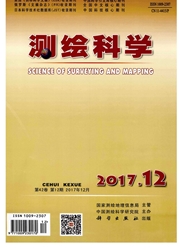

 中文摘要:
中文摘要:
高分辨率遥感影像数据量大、细节丰富并呈现出一定的尺度依赖性,单一尺度遥感影像分割难以同时兼顾影像的宏观和微观特征,这成为制约遥感信息自动化提取技术发展的瓶颈之一。对此本文提出了基于特征的多尺度高分辨率遥感信息提取技术框架,并分析了其对于大尺度海量数据信息提取与目标识别工作具有的理论及实践意义。根据影像光谱或纹理等特征,提出采用GMRF—SVM方法在大尺度上进行分类的目标区域划分方法。从大尺度信息提取的角度来看,该方法综合了GMRF纹理分类和SVM少量样本模式识别的优势,便于先验知识的融合,无论从花费时间还是分类处理效果上,都远远优于直接采用GMRF进行分割所取得的效果,对于后面的信息提取和目标识别来说更具有实际意义。
 英文摘要:
英文摘要:
This paper proposes the framework of multi-scale information extraction from high resolution remote sensing images based on features. Firstly, the image is roughly classified into different regions containing different objects. Secondly, the parcel units are extracted in related above regions (subtle segmentation). Then, the features of parcels are expressed. Finally, information or targets are extracted by parcel-based supervised classification or intelligent illation. Then this paper analyses its theoretical and practical significance to information extraction from tremendous data on large scale. Based on the spectrum and texture of images, this paper presents a region partition method in high resolution remote sensing image based on GMRF-SVM, that is the image classification based on GMRF-SVM. This method integrates the advantages of GMRF-based texture classification and SVM-based pattern recognition with small samples and makes it convenient to utilize apriori knowledge. In the end, this paper gives the tests with IKONOS image. From the point of view of information extraction on large scale, the experimental results show that the method of this paper is superior to GMRF-based segmentation whether on the time expenditure or on the processing effect. Furthermore, it is practically meaningful to the posterior work of information extraction and targets recognition.
 同期刊论文项目
同期刊论文项目
 同项目期刊论文
同项目期刊论文
 期刊信息
期刊信息
